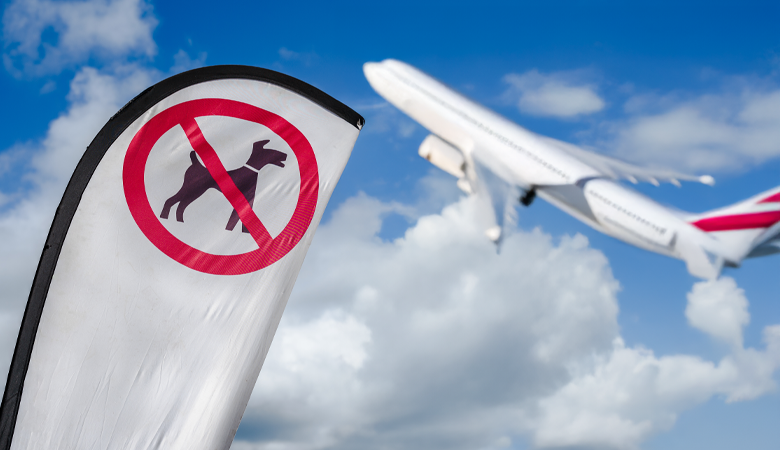Travelling with 'dangerous' dog breeds
Did you know that some countries prohibit certain dog breeds? These are often referred to as ‘dangerous’ breeds. The specific breeds banned vary by country.
In the Netherlands, for example, certain breeds require a Behaviour and Society test (OGM) to apply for a pedigree. This aims to prevent unwanted (aggressive) behaviour in these breeds.
In the Netherlands, the following breeds are subject to such requirements:
- American Staffordshire Terrier
- Dogo Argentino
- Rottweiler
- Mastino Napoletano
- Fila Brasileiro
Rules regarding so-called ‘dangerous’ breeds vary per country.
Below we outline the additional requirements for travelling with your dog to:
- Belgium
- Germany
- France
- UK
- Austria
- Italy
- Spain
Can I take my dog to Belgium?
If your dog has a valid European Pet Passport, rabies vaccination, and a registered microchip, you can travel to Belgium.
There are no breed-specific bans in Belgium.
Can I take my dog to Germany?
In Germany, dogs must be safely secured in the car using a seatbelt, travel crate or behind a dog barrier. Read more in our blog: Seatbelt rules for dogs in Germany.
Some federal states require dogs to be leashed and/or muzzled.
You may not stay for more than four weeks with certain ‘dangerous’ dog breeds, including:
- Pit Bull Terrier
- American Staffordshire Terrier
- Staffordshire Bull Terrier
- Bull Terrier
Special documentation is required for these breeds, such as a pedigree, vaccination passport, and behavioural certificate.
Some states and municipalities have additional restricted breed lists. Check with local authorities or the German Ministry of Agriculture for up-to-date rules.
Can I take my dog to France?
France divides ‘dangerous’ dogs into two categories:
Category 1: Dogs without an FCI-recognised pedigree resembling:
- American Staffordshire Terrier (Pit Bulls)
- Mastiff
- Tosa
- Crossbreeds of these, including Boerboel
These dogs are banned from ownership, import, and transit in France.
Category 2: Dogs with a recognised pedigree:
- American Staffordshire Terrier
- Tosa
- Rottweiler
- Rottweiler-like crossbreeds
These dogs are allowed under strict conditions: a French-language course, behavioural test, muzzle, lead and liability insurance. See official guidelines for full details.
Can I take my dog to the UK?
The UK is no longer part of the EU. Northern Ireland follows EU pet travel rules, but Great Britain is a ‘third country’.
A rabies titre test is not required for travel between the UK and the EU.
Dogs must be transported safely in vehicles (seatbelt, crate, or barrier). The UK Highway Code states that animals must not distract the driver or cause danger.
The following breeds are banned in the UK:
- Pit Bull Terrier
- Japanese Tosa
- Dogo Argentino
- Fila Brasileiro
- Dogs or crossbreeds resembling these
Deworming with Milbemax (Praziquantel) is required 24 to 120 hours before arrival. The treatment must be recorded in the passport with all required details.
Returning to the Netherlands? You must complete an owner declaration stating the pet is not for transfer of ownership. This form is available via the NVWA or LICG websites.
Can I take my dog to Austria?
Austria follows EU travel rules. Some districts may impose leash or muzzle rules or have breed-specific restrictions. Contact the Austrian Ministry of Health for local guidance.
Can I take my dog to Italy?
No breed-specific rules apply. You must carry a muzzle and use it when required by authorities or if others’ safety is at risk. In public and urban areas, dogs must be on a lead no longer than 1.5 metres.
Can I take my dog to Spain?
Pets are not always welcome in Spanish hotels. The following breeds are considered potentially dangerous:
- Pit Bull Terrier
- Staffordshire Bull Terrier
- Dogo Argentino
- Rottweiler
- Fila Brasileiro
- American Staffordshire Terrier
- Tosa Inu
- Akita Inu
- Crossbreeds
Also applies to dogs with certain features or aggressive history. Requirements: lead, muzzle, municipal licence, liability insurance (min. €120,000), fitness and psychological certificates, and a criminal record check. Rules vary by region – check with the Spanish embassy.
Flying with dangerous dog breeds
Flying rules vary by airline, destination, and breed. Some airlines refuse certain breeds; others allow them under strict conditions such as muzzling or crate transport. Always check with the airline in advance.
Travelling with dogs in Europe
As you can see, there’s a lot to consider when planning a trip with your dog – especially if your dog’s breed is restricted in some countries.
Going on holiday? Visit our page On holiday with your pet for everything you need to know – whether your dog joins you or stays at home.
Still have questions? Contact us at veterinarian@vetsend.co.uk.




